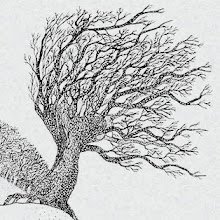«In recalling the impressions we have received from the works of man, after a lapse of time long enough to involve in obscurity all but the most vivid, it often happens that we find a strange preeminence and durability in many upon whose strength we had little calculated, and that points of character which had escaped the detection of the judgment, become developed under the waste of memory; as veins of harder rock, whose places could not at first have been discovered by the eye, are left salient under the action of frosts and streams. The traveller who desires to correct the errors of his judgment, necessitated by inequalities of temper, infelicities of circumstance, and accidents of association, has no other resource than to wait for the calm verdict of interposing years; and to watch for the new arrangements of eminence and shape in the images which remain latest in his memory; as in the ebbing of a mountain lake, he would watch the varying outlines of its successive shore, and trace, in the form of its departing waters, the true direction of the forces which had cleft, or the currents which had excavated, the deepest recesses of its primal bed.
In thus reverting to the memories of those works of architecture by which we have been most pleasurably impressed, it will generally happen that they fall into two broad classes: the one characterized by an exceeding preciousness and delicacy, to which we recur with a sense of affectionate admiration; and the other by a severe, and, in many cases, mysterious, majesty, which we remember with an undiminished awe, like that felt at the presence and operation of some great Spiritual Power. From about these two groups, more or less harmonised by intermediate examples, but always distinctively marked by features of beauty or of power, there will be swept away, in multitudes, the memories of buildings, perhaps, in their first address to our minds, of no inferior pretension, but owing their impressiveness to characters of less enduring nobility to value of material, accumulation of ornament, or ingenuity of mechanical construction. Especial interest may, indeed, have been awakened by such circumstances, and the memory may have been, consequently, rendered tenacious of particular parts or effects of the structure; but it will recall even these only by an active effort, and then without emotion; while in passive moments, and with thrilling influence, the image of purer beauty, and of more spiritual power, will return in a fair and solemn company; and while the pride of many a stately palace, and the wealth of many a jewelled shrine, perish from our thoughts in a dust of gold, there will rise, through their dimness, the white image of some secluded marble chapel, by river or forest side, with the fretted flower-work shrinking under its arches, as if under vaults of late-fallen snow; or the vast weariness of some shadowy wall whose separate stones are like mountain foundations, and yet numberless.»
In thus reverting to the memories of those works of architecture by which we have been most pleasurably impressed, it will generally happen that they fall into two broad classes: the one characterized by an exceeding preciousness and delicacy, to which we recur with a sense of affectionate admiration; and the other by a severe, and, in many cases, mysterious, majesty, which we remember with an undiminished awe, like that felt at the presence and operation of some great Spiritual Power. From about these two groups, more or less harmonised by intermediate examples, but always distinctively marked by features of beauty or of power, there will be swept away, in multitudes, the memories of buildings, perhaps, in their first address to our minds, of no inferior pretension, but owing their impressiveness to characters of less enduring nobility to value of material, accumulation of ornament, or ingenuity of mechanical construction. Especial interest may, indeed, have been awakened by such circumstances, and the memory may have been, consequently, rendered tenacious of particular parts or effects of the structure; but it will recall even these only by an active effort, and then without emotion; while in passive moments, and with thrilling influence, the image of purer beauty, and of more spiritual power, will return in a fair and solemn company; and while the pride of many a stately palace, and the wealth of many a jewelled shrine, perish from our thoughts in a dust of gold, there will rise, through their dimness, the white image of some secluded marble chapel, by river or forest side, with the fretted flower-work shrinking under its arches, as if under vaults of late-fallen snow; or the vast weariness of some shadowy wall whose separate stones are like mountain foundations, and yet numberless.»
John Ruskin, The seven Lamps of Architecture (1849)






0 comentarios:
Publicar un comentario